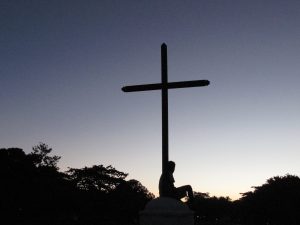“It’s the most wonderful time of the year!” Or so the carol declares. Christmas time is upon us, although I am not entirely sure how December got here so quickly. I’m still trying to figure out where June and July went. While I’m looking for my seemingly lost time you can hang your stockings by the chimney with care.
Speaking of stockings, what is it with all these Christmas traditions? The trees, the lights, the strange man dressed rather conspicuously who breaks into our houses and leaves packages in our living rooms? When did all of this stuff come along, and why? How does any of this fit into the story of Jesus’s birth anyways? There is much about Christmas that seems mystifying, but a lot of it has a very simple and fascinating history. The term “Christmas” for example is a compound word originating from when Roman Catholic masses would be held in December, i.e. “Christ’s Mass.”
Ever wondered what on earth a “Yule” was? It’s an Old English word (Gēola) which represented the winter months of December and January. As time went on it simply got wrapped up in representing the Christmas season. And here I was thinking it was just a redicyules made up word. I guess I had a yuleterior motive, maybe my mode of thinking was too minuscyule? Alright, alright, I’ll stop… Yule be sorry I didn’t go on though.
Happy birthday, Jesus!
Although we celebrate Jesus’s birth on December 25th, the reality is that no one really knows the date of Jesus’ actual birth. Some in the early church believed it had to have been the spring due to the shepherds’ presence in the fields. Shepherds were in the fields from March to November; and during the winter rain months they would not have had their livestock grazing. The early Church Father Clement of Alexandria (AD 150-215) argued strongly that it was in November (the 17th, of 3 BC to be exact) that Jesus was born.
So why December 25th then? The earliest evidence we have of that date specifically comes from 354 AD when the Bishop of Rome was said to have observed the date of Christ’s birth on that particular day. There are two running hypotheses as to why that date was chosen. The first is what is known as the religions hypothesis. The idea being, that there were four major Roman festivals held in December already. Some speculate that as Christianity grew in popularity in antiquity, converts to Christianity would commandeer the pagan festivals they would have normally celebrated on that date by replacing them with a celebration of Jesus.
The second theory is known as the calculation hypothesis. In order to understand this theory we need to understand that there was an idea within early Christianity that if you were really holy you would die on your birthday. This was calculated mainly because the Old Testament would record the life of individuals like Moses and present round numbers (without adding months or days) for how long they lived. For example, in Deuteronomy 3:7 it says that, “Moses was a hundred and twenty years old when he died.” Well the most holiest man who ever lived was Jesus, therefore the early church thought he must have died on his birthday. The early church thought that Jesus was conceived on March 25 (on the vernal equinox – for specific reasons I don’t have time to get into), and assuming Mary’s pregnancy was nine months long, that would end on December 25th with the winter solstice.
Fuzzy Details
We often have ideas of how the story on the first Christmas went down. Unfortunately, a lot of our preconceived notions come from the songs we sing at this time of year and not from the biblical narratives themselves. For example, neither of the stories in the biographies of Luke or Matthew tell us that Mary rode a donkey into Bethlehem, that the innkeeper turned the needy couple away (only that there was no room in the inn), or that the birth event took place immediately upon arrival. It doesn’t say that there were specifically three wise men (three gifts, but the number of the bearers is never specified), or that the Magi arrived the day of the birth. In fact, the biblical text implies that Jesus could have been anywhere between infancy and the age of two when the Magi made their appearance.
Likewise, due to what we know of the evidence from the time period, Jesus was most likely not born in what we picture as our modern day stables. The location probably resembled more of a cave or shelter built into a hillside. Archeological discoveries from the late first century BC and early first century AD show that the countryside of Bethlehem during the time would have been dotted with small caves that would have housed livestock. What is now the Church of the Nativity was established in the fourth century by Emperor Constantine’s mother, Helena, over a probable livestock cave of the time.
And let’s be honest, a teenager giving birth in a cave next to livestock probably didn’t make for the most “silent night.”
Spruce-up the Season with a Tree!
Although the tradition of bringing trees into one’s house during the winter solstice is often attributed to ancient and early Medieval pagans, this is a complete fabrication. In fact, the Protestant Reformer Martin Luther is credited as the first person to bring a tree indoors and decorate it with lights. The story goes that during a winter evening stroll Luther was overcome by the brilliance of the stars in the night sky, painting the background over the evergreen forests. In order to capture this moment it is recorded that Luther cut down and erected a tree in the main hall of their house, covering its branches with lighted candles.
Although the tradition was well known from that point on in Germany (and dispersed parts of Europe) it was not practiced in Britain until the 19th century. When Queen Victoria married her German cousin Prince Albert, the custom was brought into the household of the British royal family. From then on it was associated with Royalty, and wealthier middle-class families soon followed suit with the tradition during the holiday season. Canada however, had adopted the tradition just prior in the 1700s where we have records of Brunswick soldiers stationed in Quebec who are said to have decorated large fir trees with candles and fruit during the holiday season.
A Loophole in the Santa Clause
The historical St. Nicholas was Bishop of Myra, situated in modern day Demre, Turkey during the fourth century. During the persecution of the Church under the Roman Emperor Diocletian, Nicholas was imprisoned. After the Edict of Milan in AD 313 and the decriminalization of Christianity in the Roman empire under Emperor Constantine, Nicholas was released and was even present at the famous Council of Nicaea (May-June, AD 325). According to oral tradition, when the heretical teacher Arius denied the eternal existence of Jesus as the second person of the Trinity, Nicholas stood up and punched him in the face. However, this story is much more lore than it is history and we can never know whether Jolly Ol’ St. Nick truly did lay the smackdown on the heretics at the first ecumenical council.
During the Middle Ages, children were given gifts in honour of St. Nicholas. During the Reformation in an attempt to draw attention away from saint veneration, Martin Luther would lay out gifts out on Christmas Eve and tell children that “Holy Christ” had delivered them. “Holy Christ” in his native German was pronounced “Christkind” which years later was Anglicized and morphed into “Chris Kringle.” Later Protestant tradition would end up melding the titles of St. Nicholas and Christkind along with the British “Father Christmas” into the same character.
Christmas is fun. And sure, much of our modern day tradition and celebration have little to do with how it would have been originally remembered or celebrated. That’s not necessarily a bad thing. Nonetheless, Christmas is special because of what sits at the heart of it. Not the specific date, the details in the carols, the trees and decorations, or an elderly bearded man who commits home invasion to eat our milk and cookies. What sits at the heart of Christmas is the centre point of history – the Word becoming flesh and making his dwelling among us (John 1:14). The season is less about the presents and far more about the Presence. For “we have seen His glory, the glory of the one and only Son, who came from the Father, full of grace and truth… Out of His fullness we have all received grace in place of grace already given” (John 1:14b, 17).
All the rest aside, Christmas is the amazing remembrance of an unfathomable mystery – that the Creator of the universe would be willing to step into humanity to save it. The reality of “Immanuel” (a Hebrew word meaning “God with us”), is the beginning of the unimaginable event of Jesus’ earthly life, ministry, death, and resurrection. An event worth celebrating till, as the apostle Paul writes, “the happy fulfillment of our home in the glorious appearing of our great God and Saviour, Jesus Christ” (Titus 2:13).
"*" indicates required fields
Share this!
About the Author





